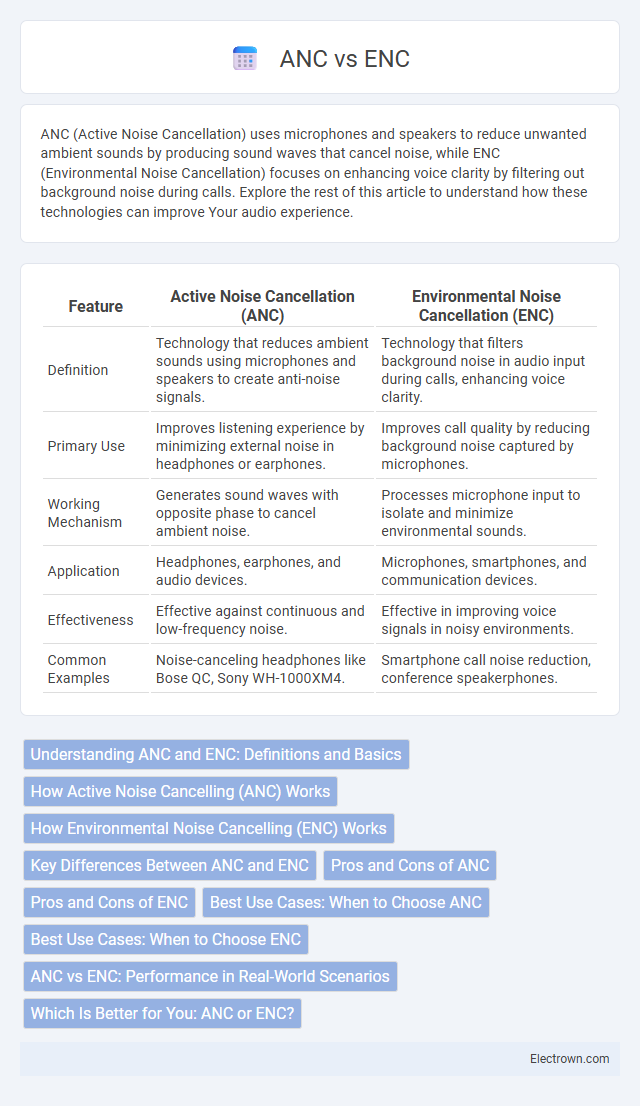ANC (Active Noise Cancellation) uses microphones and speakers to reduce unwanted ambient sounds by producing sound waves that cancel noise, while ENC (Environmental Noise Cancellation) focuses on enhancing voice clarity by filtering out background noise during calls. Explore the rest of this article to understand how these technologies can improve Your audio experience.
Table of Comparison
| Feature | Active Noise Cancellation (ANC) | Environmental Noise Cancellation (ENC) |
|---|---|---|
| Definition | Technology that reduces ambient sounds using microphones and speakers to create anti-noise signals. | Technology that filters background noise in audio input during calls, enhancing voice clarity. |
| Primary Use | Improves listening experience by minimizing external noise in headphones or earphones. | Improves call quality by reducing background noise captured by microphones. |
| Working Mechanism | Generates sound waves with opposite phase to cancel ambient noise. | Processes microphone input to isolate and minimize environmental sounds. |
| Application | Headphones, earphones, and audio devices. | Microphones, smartphones, and communication devices. |
| Effectiveness | Effective against continuous and low-frequency noise. | Effective in improving voice signals in noisy environments. |
| Common Examples | Noise-canceling headphones like Bose QC, Sony WH-1000XM4. | Smartphone call noise reduction, conference speakerphones. |
Understanding ANC and ENC: Definitions and Basics
Active Noise Cancellation (ANC) uses microphones and speakers to detect and counteract external noise waves, creating a quieter listening environment. Environmental Noise Cancellation (ENC) focuses on filtering ambient sounds during calls by isolating your voice from background noise using advanced algorithms. Understanding these technologies helps you choose headphones or earbuds that best suit your noise reduction needs.
How Active Noise Cancelling (ANC) Works
Active Noise Cancelling (ANC) technology uses microphones to detect ambient sounds and generates inverse sound waves to neutralize external noise, creating a quieter listening environment. This real-time sound wave analysis and cancellation primarily target low-frequency sounds such as engine hums or air conditioning. Unlike Environmental Noise Cancelling (ENC), which enhances voice clarity by filtering background noise during calls, ANC focuses on immersive sound experience by reducing environmental noise.
How Environmental Noise Cancelling (ENC) Works
Environmental Noise Cancelling (ENC) uses built-in microphones to detect external ambient sounds and processes these signals with advanced algorithms to filter out background noise in real-time. Unlike Active Noise Cancelling (ANC), which actively generates anti-noise waves to cancel low-frequency sounds, ENC focuses on improving call clarity by isolating and reducing environmental noise around the microphones. This technology is especially effective in distinguishing and suppressing human speech and high-frequency noises for clearer voice transmission.
Key Differences Between ANC and ENC
ANC (Active Noise Cancellation) reduces ambient sound by generating inverse sound waves, effectively minimizing background noise for clearer audio in noisy environments. ENC (Environmental Noise Cancellation) enhances voice clarity by filtering out background noise during calls using microphones and signal processing technology. Your choice depends on whether you prioritize immersive sound experience (ANC) or improved communication quality (ENC).
Pros and Cons of ANC
Active Noise Cancelling (ANC) technology effectively reduces constant, low-frequency ambient sounds such as airplane engine noise or air conditioning hum, enhancing audio clarity during playback. Its main advantage is improved listening experience in noisy environments, but it can cause slight audio distortion and consume more battery power compared to passive noise reduction. ANC is less effective against sudden, high-frequency sounds and can add to the overall cost and complexity of headphones or earbuds.
Pros and Cons of ENC
Environmental Noise Cancellation (ENC) excels in improving call clarity by reducing background noises using external microphones designed for voice capture, making it ideal for phone and video calls in noisy environments. However, ENC primarily targets voice frequencies and cannot effectively cancel broad-spectrum noise like music or ambient sounds, limiting its utility in immersive audio experiences. The technology typically consumes less power than Active Noise Cancellation (ANC), but it does not provide the same level of overall noise reduction for general listening purposes.
Best Use Cases: When to Choose ANC
Active Noise Cancellation (ANC) is best suited for environments with consistent, low-frequency sounds such as airplane cabins, trains, or busy offices, effectively reducing background hum and allowing for better focus or relaxation. If you frequently encounter steady noise sources and want to immerse yourself in music or work without distractions, ANC headphones provide superior sound isolation. Your choice should favor ANC when passive noise blocking is insufficient and situational noise is predictable and continuous.
Best Use Cases: When to Choose ENC
Environmental Noise Cancellation (ENC) excels in outdoor and noisy environments where wind and ambient sounds are prevalent, making it ideal for phone calls and casual listens while on the move. ENC uses multiple microphones to filter out background noise specifically during voice communication, ensuring clearer conversations. You should choose ENC if your primary need is improving call quality in dynamic, noisy settings rather than immersive music listening.
ANC vs ENC: Performance in Real-World Scenarios
Active Noise Cancellation (ANC) effectively reduces consistent, low-frequency background sounds such as airplane engines and air conditioning, enhancing immersion in noisy environments. Environmental Noise Cancellation (ENC) excels in filtering out human speech and sudden ambient noises during phone calls, improving voice clarity and communication quality. Real-world scenarios often benefit from combining ANC for immersive audio experiences and ENC for superior call performance in dynamic sound environments.
Which Is Better for You: ANC or ENC?
Active Noise Cancellation (ANC) uses microphones and speakers to actively reduce environmental noise, ideal for immersive listening in noisy places like airplanes or urban streets. Environmental Noise Cancellation (ENC) primarily focuses on eliminating background sounds during calls, enhancing voice clarity in conversations rather than overall sound experience. Choosing ANC benefits users seeking distraction-free audio, while ENC suits those prioritizing clear communication in loud environments.
ANC vs ENC Infographic

 electrown.com
electrown.com